Saffron Days in La Mancha, Spain
Celebrate with the Spanish as they harvest saffron, one of the world’s most expensive spices
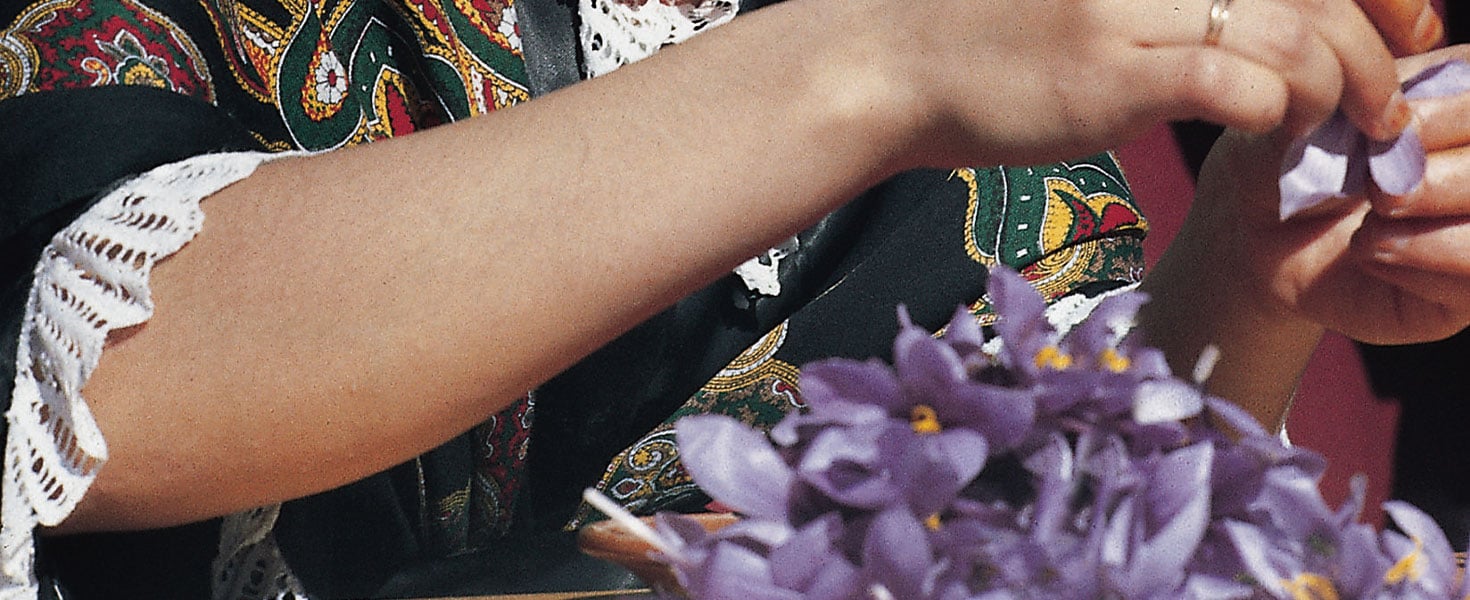
It’s the end of October and the fields of Consuegra, Spain, are awash in deep purple.
After a hot, arid summer, when temperatures typically flirt with the 100-degree mark, the landscape here commonly takes on the color of straw. The barley and wheat crops have already been harvested. Pasturelands have been bleached by a season of unrelenting sun, and it’s been months since any measurable rain has fallen.
And yet now, the plains before me pop with color. For two short weeks, hundreds of acres of purple crocuses will brighten the otherwise beige landscape, signaling the approach of the saffron harvest and, with it, Consuegra’s Saffron Rose Festival.
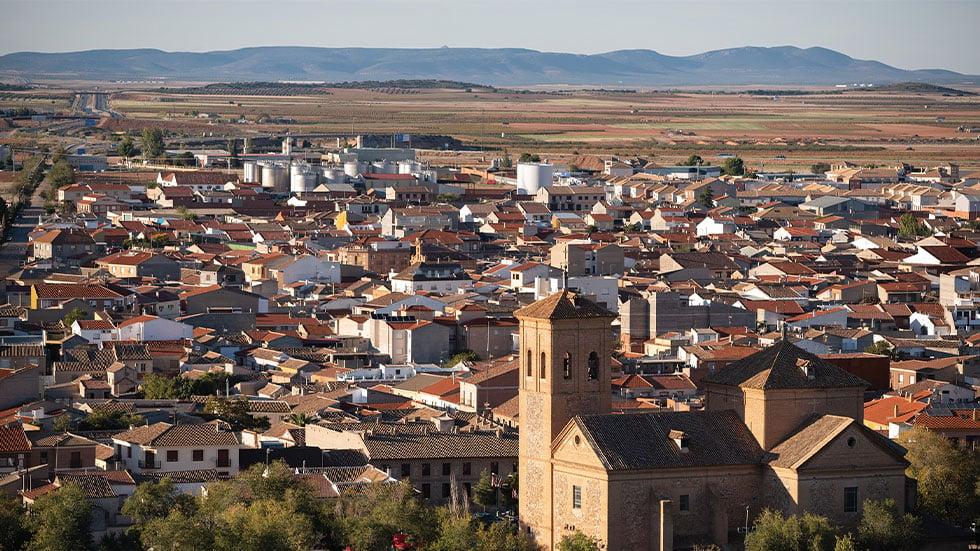
The village of Consuegra; Photo by Michael C. Snell
The village of Consuegra lies in the heart of the historic region of La Mancha, a broad plateau that stretches to the south and east of Madrid. Best known to Americans as the setting for Dale Wasserman’s Man of La Mancha, loosely based on Miguel de Cervantes’ novel Don Quixote, the region offers Roman ruins, Medieval stonework, and the tourist hot spot of Toledo, home to distinctive Moorish architecture and the painter El Greco.
But it is the saffron harvest that draws Manchegans, gourmets and festivalgoers to Consuegra in the fall. Although Spanish speakers refer to the rosa del azafrán, or the saffron rose, saffron is actually a member of the crocus family. Its Latin binomial is Crocus sativus, and it is the only crocus that produces saffron, which ranks among the rarest and most sought-after culinary ingredients in the world.
The saffron crocus was introduced to central Spain at least 1,000 years ago during the Muslim conquest. The plant proved extraordinarily well-suited to the region’s hot, dry environment and, thus, secured its place in the agricultural and culinary landscape here. The saffron crocus is cultivated throughout the Mediterranean and Asia Minor, but Spain ranks as the world’s second-largest producer of saffron. (Iran takes the top spot.)
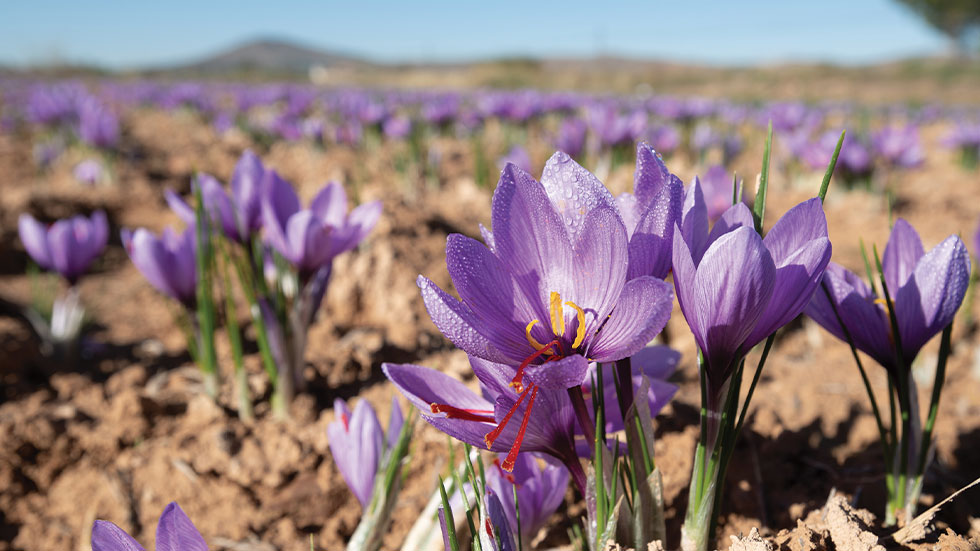
Mature saffron crocuses ready for harvest; Photo by Michael C. Snell
CELEBRATING SAFFRON
Tracing its roots to 1963, the annual Saffron Rose Festival—to be held October 25 to 27 in 2024—features food cook-offs, saffron-themed markets, folk music and dance, and tasting menus. But it is the festival’s stigma-plucking contest that holds me in thrall on this autumn afternoon.
Beneath a large white tent in Consuegra’s Plaza España, some 500 festivalgoers wait in silence, their gazes focused on the front of the room. There, at a long table draped in white linen, eight contestants sit at nervous attention, postures stiff, hands in their laps, vibrant purple crocuses heaped in piles before them.
The emcee’s voice echoes through the microphone: “Uno, dos…tres!” and the contestants spring into action. Their fingers grasp and then remove the curling red stigmas tucked within each blossom. Working intently, the contestants make their way through the flower mounds, collecting the crimson threads in ceramic dishes and amassing growing piles of stripped crocuses. The delicate red stigmas will later be oven-dried and packaged for sale as saffron.
A signal goes off to mark the end of the three-minute contest, and participants’ piles are evaluated by a panel of judges. They will determine how many stigmas each person harvested, whether their harvested threads are fully intact and whether any piles contain too many broken bits. The judges will also examine the stripped flowers to see how many retain traces of unplucked stigmas. The final tallies will determine the winner of this year’s competition and a year’s worth of bragging rights.

Saffron threads; Photo by Gummy Bear/stock.Adobe.com
The ability to hand-pluck saffron threads is more than just a festival game in Consuegra. Because of the flower’s fragility, Spain’s saffron crocus fields are still harvested by hand and gathered in straw baskets, as they have been for centuries. And because of the delicate quality of the crocus’s stigmas, they, too, must be picked and sorted by hand. The rarity of the saffron crocus and the ease with which the threads can be damaged make this spice the world’s most expensive by weight.
Lovely as the saffron crocus may be, its raison d’être is best discovered at the table, and so I head out to sample the local fare. Earthy and mildly bitter in taste, saffron’s subtleness on the tongue contrasts with its brilliant orange-gold appearance.
Saffron is key to properly seasoning paella, the baked rice casserole that’s the unofficial national dish of Spain and a menu mainstay at Consuegran restaurants. But as so commonly happens at food festivals, the star ingredient makes its way into all kinds of menu items. Martinis are sprinkled with red saffron bits. Slices of Manchego cheese (another local specialty) arrive at the table dusted prettily with crumbled saffron, dried lavender and toasted walnuts. Fish tacos are dressed with garlic-saffron sauce. And for dessert, there’s saffron-infused flan and ice cream.
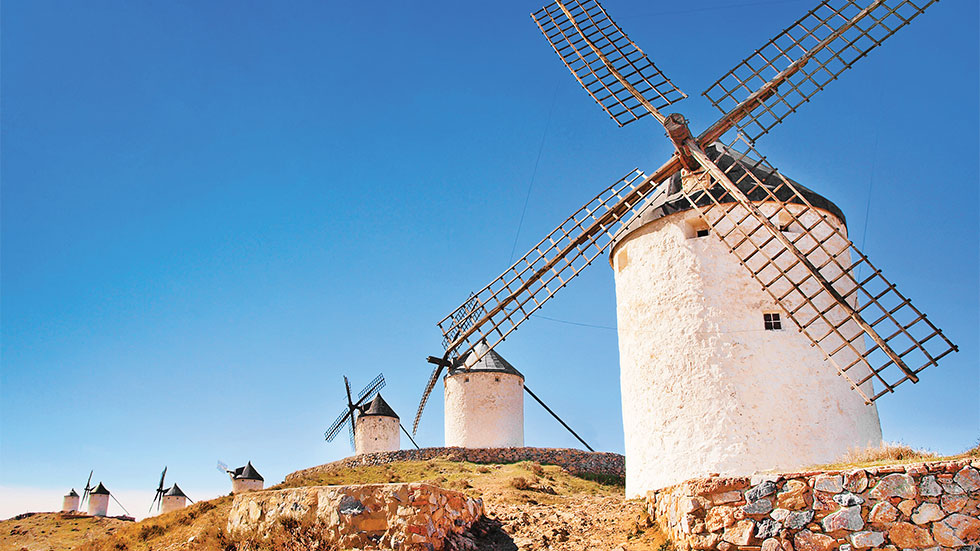
Consuegra’s windmills; Photo by JFL Photography/stock.adobe.com
SAFFRON MEETS CERVANTES
If the saffron crocus is the centerpiece of this festival, the flower doesn’t stand entirely alone: The Saffron Rose Festival also incorporates activities that promote the town’s unique history, music and traditions. And Consuegra has plenty of culture worth touting.
Sitting on a crest of land above town, for instance, Calderico Hill is crowned with a row of 12 windmills that form one of Spain’s most famous landmarks. Originally constructed in the 16th century and made famous by Cervantes in Don Quixote, the white towers serve as important characters in the scene that coined the phrase “tilting at windmills.” Their iconic status and sheer beauty make them a natural backdrop for many of the festival’s cultural events, including traditional dance performances and folk music concerts.
And so, as Sunday morning dawns, I follow a footpath that snakes up the hill, eager to view the windmills alone and under a rainbow-sherbet sky. The conical windmills, each outfitted with four latticed blades, stand regally atop the ridge, devoid of the crowds that will arrive a few hours from now. Their whitewashed walls reflect a warm, golden hue. It seems only natural that Cervantes sought a way to immortalize them in verse—and equally so that the Saffron Rose Festival would center its folkloric activities here. The windmills serve as an ongoing attraction, long after the flowers have faded.
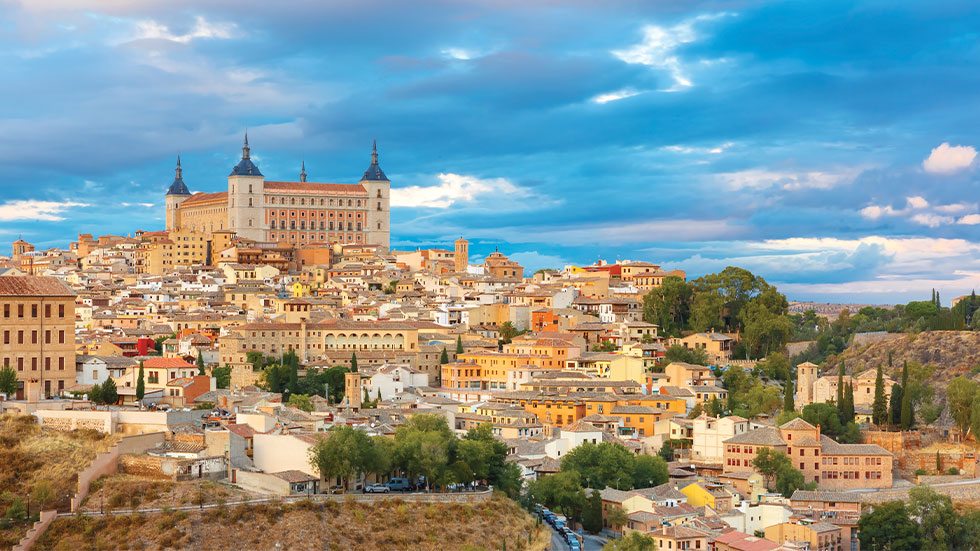
The city of Toledo rises above the Tagus River; Photo by Photo by Kavalenkava/stock.adobe.com
TOURING TOLEDO
Several other destinations worth visiting are within an easy drive of Consuegra. Among them, Segóbriga Archaeological Park preserves the remains of a Roman settlement with ruins of a circus, a theater, public baths, temples and a large amphitheater that researchers believe was used for giant parties. The hilltop town of Cuenca is famous for the Museum of Spanish Abstract Art and its “hanging houses,” residences perched so precariously along the cliff faces that they appear to be suspended.
But I am most intrigued by the city of Toledo. I arrive in the evening, as day-trippers from Madrid begin heading back to the city and crowds begin to thin. At dusk, the city’s 14th- and 15th-century buildings and fortified walls high above the sparkling Tagus River glow in the rosy evening light. The towers of the Renaissance-era Toledo Cathedral and Alcázar Fortress soar above it all.
Toledo calls itself “the City of Three Cultures,” referring to its embrace of Christian, Jewish and Muslim traditions. Established as a Roman outpost in 59 BC, the city took turns as the capital of the Visigoths, a stronghold of the Emirate of Cordoba, and an imperial seat of the 16th-century Holy Roman Emperor Charles V.
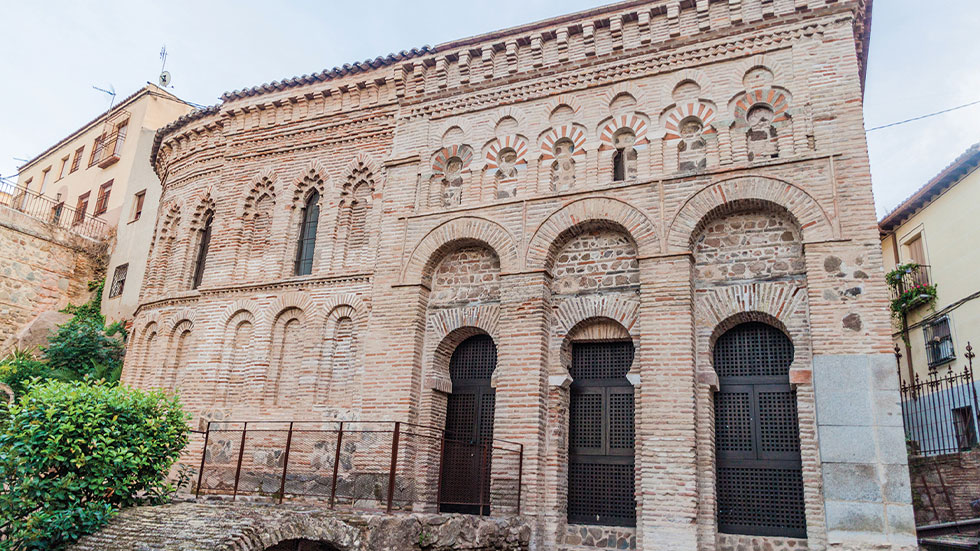
Toledo’s 1,000-year-old Cristo de la Luz Mosque; Photo by Matyas Rehak/stock.adobe.com
Each of Toledo’s cultures melded with its predecessors, recycling pieces of old buildings into the contemporary and reinventing the architectural styles of bygone empires into the present. The uniquely Iberian mix may be best exemplified by the 1,000-year-old Cristo de la Luz Mosque, which is surrounded by original Roman paving stones, built using Visigothic capitals, and adorned with 13th- and 14th-century Christian frescoes added after the Spanish reconquest. Similarly, the Santa Maria la Blanca Synagogue, constructed in the 12th century as Toledo’s primary synagogue, includes Christian art from the reconquest.
More than four centuries ago, the painter Doménikos Theotokópoulos, familiarly known as El Greco, was perhaps as entranced as I by Toledo’s charms. The El Greco Museum sits within the Jewish Quarter, inside an assemblage of renovated 16th-century residences thought to include El Greco’s home. Paintings of biblical scenes, Christ, and numerous apostles and saints brighten the walls of a contemporary exhibition space modernized most recently in 2011. At the center of the modern section stands a 16th-century courtyard once occupied by Marquis de la Vega-Inclán, who founded the museum in 1911. Below ground are the brick galleries, warehouses and mikvah of a 14th-century palace.
After taking my leave of El Greco, I head into the serpentine, cobbled streets of the Jewish Quarter for dinner. Just a few steps away from the museum, I discover Lo Nuestro, a taperia that touts its wide array of Manchegan ingredients. Scanning the menu, I see savory soups and a half-dozen varieties of paella in the list, all of them seasoned with local saffron. Would the bartender sprinkle my cocktail with saffron threads, too? There is only one way to find out. I open the door and take a seat.
